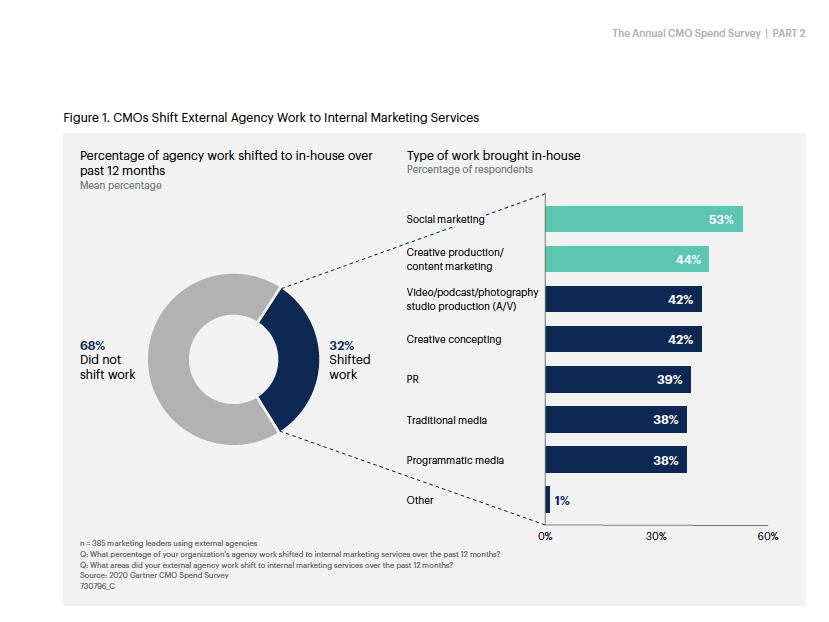In part 1 of our Gartner series, we analyzed the ways the pandemic has forced a global reset when it comes to navigating the current business ecosystem. The emphasis here was on adapting and resetting business strategies rather than pausing and waiting for life to go back to “normal”.
Current events have massively impacted the shift to digital; accelerating the timeline for digital transformation and propelling us into the enlightenment era of technical revolution a decade sooner than predicted. So, what does this mean for your company, brand, and overall customer service?
Today we’ll cover those challenges by exploring digital transformation, resource optimization, and personalization in 2020 and beyond.
Say goodbye to predictive marketing
According to Gartner’s CMO spend survey, “The COVID-19 crisis has shifted CMOs’ focus from customer acquisition to customer retention and growth”. Meaning, the models used to drive predictions are no longer considered as accurate. This economic unpredictability is leaving CMOs, CTOs, and CFOs in search of a more sustainable strategic direction for their investment.
We’d argue this leaves just one approach – implement personalized experiences to ensure your current customers remain happy. This can be done through empathetic marketing.
Businesses will not only strengthen customer loyalty with this method, but they will build trust and save resources by using existing data to reinforce positive experiences through customization.
The goal is to create content or, as Sitecore said, “Businesses need to adopt a ‘moment to moment’ mindset and deliver a CX that demonstrates the ways you understand your customers by building a customized pathway.” These moments resonate with your clients’ specific needs, wants, and emotions leaving them feeling appreciated in their CX.
The challenges of a digital transformation
2020 has truly transformed CX and how we conduct business, but we’re still seeing a lot of resistance.
Experienced IT teams know technology will continue to challenge the ways we do business and perform daily tasks. However, the struggle we’re seeing is a preconceived notion that off-site and on-site environments affect deliverables. We’re here to tell you that assumption is totally incorrect. The quality of your services does not rely on whether your team is based on or off site. That’s a rookie misconception.
Hint: We’re living a new normal. As Paige O’Neill noted at Sitecore Symposium, research is showing that 75% of people who are using digital channels for the first time say they’re going to keep on using them.
We don’t mean to sound like a broken record but pausing your business’s progress will only do harm in the long run.
Cutting costs in the right places
We previously discussed the ways COVID-19 caused some serious budget cuts. The issue we’re looking at today is the reasoning behind these cuts and why they are being made in the wrong areas.
The majority of these cutbacks are not beneficial to business success because they are being driven by fear instead of strategy.

Gartner’s survey exhibits the ways CMOs are optimizing costs by turning away from agencies and focusing on in-house teams for support rather than third-party experts. The statistics don’t lie; this is a poor tactic because it will, if it hasn’t already, contribute to additional setbacks.
“For CMOs optimizing costs, pursuing in-housing can turn into a futile effort. It first requires putting people on the payroll, establishing new processes to manage the movement of work, and investing in technology to support the changes. And that assumes CMOs are able to recruit and retain the necessary talent. This shift from working with agencies to bringing work in-house is a long-term investment and involves more financial risk than relying on a contracted partner.”
Gartner: The Annual CMO Spend Survey
Your strategy should include employee loyalty and retention
The idea here is that the biggest challenge (i.e., the WFH adjustment period) is over and teams should feel confident in their ability to perform daily tasks within a remote setting. However, this will impact daily tasks and cause friction and dissatisfaction if employees are expected to do their regular job in addition to these new technical responsibilities.
If we’re being honest, there’s a good chance the issues you’re currently facing are stemming from a technology gap only a third-party partner/team can resolve.
Loyalty and retention boils down to 2 things – trust and brand resilience, which go hand in hand. You must trust in your digital platform and take advantage of your investment’s full capabilities by understanding its features, applications, and customizations options.
The path to accomplishing this? Get the most out of your digital assets by investing in training and workshops from leading professionals. Now is not the time to be fearful, it’s the time to act and strategize.
Still unsure? Content Bloom is currently offering businesses a free digital consultation and business analysis. Get in touch.





